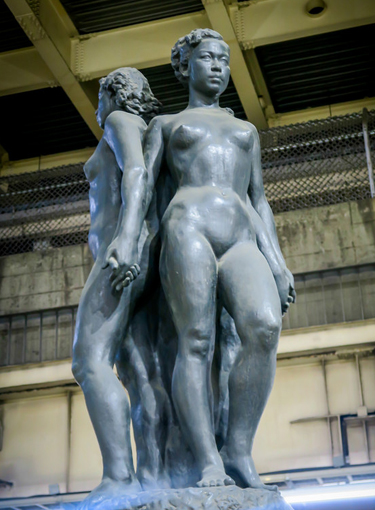Artist:
Fumio Asakura
Title:
Sanso no Zo, Three Phase Statue
Year:
1959
Adress:
Akihabara Station
www.dennisamith.com:
One of the statues (as there are three women) you will see is 'Sanso no Zo' (Three-phase statue) near the JR Ueno Station central ticket gate. Three-phase for this statue stands for 'knowledge, emotion and intention'.
When Ueno Station was celebrating its 75th anniversary commemoration on October 10, 1959 (Ueno Station opened back in July 1883), prior to the commeoration, famous sculptor Fumio Asakura decided to donate another statue on his birthday.
Asakura Fumio was a western-style Japanese sculptor and is known as the father of modern Japanese sculpture and referred to as the 'Rodin of Japan'. His work spanned the Meiji, Taisho and Showa periods of Japanese history. www.at-art.jp:
Statue of Peace Prayer ~ Wishing for permanent peace of the world ~ Flower shadow,
JR Yamanote Line · Tokyu Meguro Line Works in Meguro District Center, a 10-minute walk from Meguro Station. Nude statue that raised both hands gently.
www.taitocity.net: Asakua Museum of Sculpture was once a studio and residence of Asakura Fumio (1883-1964), a leading sculptor of modern Japan. The building is now open to the public as a museum exhibiting the collection of ASAKURA's sculptures. Visitors can enjoy viewing the world of ASAKURA and four distinct seasons of Japan.
Asakura Fumio was born in Oita Prefecture in 1883, and moved to Tokyo to stay with his brother and a sculptor, Osao Watanabe, when he was 19 years old. In the following year, 1908, he entered Tokyo Art School (present-day Tokyo University of the Arts) and began studying sculpture.
His talent was soon recognized at a competition with his "Statue of Nire Kagenori", a bronze statue of Viscount Kagenori Nire, the admiral in the early Imperial Japanese Navy.
After the graduation in 1908, his work "Darkness", won the second prize at The 2th Bunten [Ministry of Education Fine Arts Exhibition] hosted by the Ministry of Education, Science, Sports and Culture, achieving public recognition. His masterpiece "Grave Keeper", which was exhibited at The 4th Bunten, was a major turning point of his sculpture.
He began pursuing the realistic style, focusing on modern modelling technique instead of the traditional Japanese carving technique. He was the leading figure not only in the Japanese sculpture world but also in the entire Japanese art world. In 1948, Asakura became the first Japanese sculptor to receive the Order of Cultural Merit. He passed away at the age of 81 in 1964.
www.dennisamith.com:
Asakura Fumio was a western-style Japanese sculptor and is known as the father of modern Japanese sculpture and referred to as the 'Rodin of Japan'. His work spanned the Meiji, Taisho and Showa periods of Japanese history.
One of the statues (as there are three women) you will see is 'Sanso no Zo' (Three-phase statue) near the JR Ueno Station central ticket gate. Three-phase for this statue stands for 'knowledge, emotion and intention'.
When Ueno Station was celebrating its 75th anniversary commemoration on October 10, 1959 (Ueno Station opened back in July 1883), prior to the commeoration, famous sculptor Fumio Asakura decided to donate another statue on his birthday.
Asakura Fumio was a western-style Japanese sculptor and is known as the father of modern Japanese sculpture and referred to as the 'Rodin of Japan'. His work spanned the Meiji, Taisho and Showa periods of Japanese history. www.at-art.jp:
Statue of Peace Prayer ~ Wishing for permanent peace of the world ~ Flower shadow,
JR Yamanote Line · Tokyu Meguro Line Works in Meguro District Center, a 10-minute walk from Meguro Station. Nude statue that raised both hands gently.
www.taitocity.net: Asakua Museum of Sculpture was once a studio and residence of Asakura Fumio (1883-1964), a leading sculptor of modern Japan. The building is now open to the public as a museum exhibiting the collection of ASAKURA's sculptures. Visitors can enjoy viewing the world of ASAKURA and four distinct seasons of Japan.
Asakura Fumio was born in Oita Prefecture in 1883, and moved to Tokyo to stay with his brother and a sculptor, Osao Watanabe, when he was 19 years old. In the following year, 1908, he entered Tokyo Art School (present-day Tokyo University of the Arts) and began studying sculpture.
His talent was soon recognized at a competition with his "Statue of Nire Kagenori", a bronze statue of Viscount Kagenori Nire, the admiral in the early Imperial Japanese Navy.
After the graduation in 1908, his work "Darkness", won the second prize at The 2th Bunten [Ministry of Education Fine Arts Exhibition] hosted by the Ministry of Education, Science, Sports and Culture, achieving public recognition. His masterpiece "Grave Keeper", which was exhibited at The 4th Bunten, was a major turning point of his sculpture.
He began pursuing the realistic style, focusing on modern modelling technique instead of the traditional Japanese carving technique. He was the leading figure not only in the Japanese sculpture world but also in the entire Japanese art world. In 1948, Asakura became the first Japanese sculptor to receive the Order of Cultural Merit. He passed away at the age of 81 in 1964.
www.dennisamith.com:
Asakura Fumio was a western-style Japanese sculptor and is known as the father of modern Japanese sculpture and referred to as the 'Rodin of Japan'. His work spanned the Meiji, Taisho and Showa periods of Japanese history.



